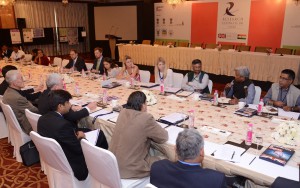26th November 2013 Bangalore, India
Engaging science and media
Last week I was lucky enough to spend three days listening to senior Indian journalists and scientists discuss how little the media covers Indian science, and how the coverage can be improved. The cause for these intense discussions were three consultation meetings we had organised, along with the Royal Society of Chemistry (RSC), Research Councils UK, CiSTUP and Vigyan Prasar.
 Why did we care how science is covered in the Indian media? The answer is simple – both the UK and India are committed to getting the most economic and societal impact out of the world-leading research we fund together. But without informed public debate of the products of research (such as emerging technologies, new policies etc) that potential will never be realised to its fullest. The media has a huge role to play informing and shaping that debate. Something which is as true in India as it is in the UK. In other words, science isn’t finished until it’s communicated.
Why did we care how science is covered in the Indian media? The answer is simple – both the UK and India are committed to getting the most economic and societal impact out of the world-leading research we fund together. But without informed public debate of the products of research (such as emerging technologies, new policies etc) that potential will never be realised to its fullest. The media has a huge role to play informing and shaping that debate. Something which is as true in India as it is in the UK. In other words, science isn’t finished until it’s communicated.
India publishes about 32,000 research papers and spends 1% of its GDP on science. However, with some notable exceptions, Indian science coverage in the media is relatively small. There are few specialised science journalists in India, leaving much of the science news to be covered by non specialist journalists. Many news publications carry syndicated reports from international agencies, which generally report findings of foreign researchers. Conversely, many Indian scientists are hesitant to talk to the media due to the fear of misquotes and adverse publicity, and sometimes find it hard to communicate their finding in simple terms. This has resulted in a wide gap between both the communities.
Countries like the UK have bridged this gap through the establishment of the UK Science Media Centre (SMC). Established over 10 years ago, it was the first of its kind (although India was in fact the first country to discuss this concept in 1997). The UK SMC is an independent platform which helps in helping scientists and journalists work with each other effectively. The SMC supports scientists to interact more effectively with journalists and helps journalists access experts easily when needed. It also helps build the capacities of both the communities in speaking to each other and building trust. It’s a model which has now been replicated around the world from Japan to Canada.
Coming back to the consultation meetings that I mentioned earlier. These meetings were held in Bangalore and New Delhi to brainstorm with scientists and journalists if there was a need to set up an Indian version of SMC and how to set it up. Taking part to share the UK experience, we had Professor Robin Grimes, Dr Helen Jamison from the UK SMC, Simon Wilde from NICE, Kate Kelland from Thompson Reuters and Dr Victoria Steven from the RSC. They shared their experiences of how the UK SMC is helping both the communities talk to each other and improve science coverage. We were also lucky enough to have UK Minister Hugo Swire MP take part in the Delhi workshop, and he underlined te value the UK places on its relationship is with India. From all the conversations and debates in both the cities, there was an overwhelming YES. All of them felt that the media plays a key role in communicating science and shaping public attitudes and could improve the range of its coverage, particularly of indigenous research. And Indian scientists should communicate to the media much more than the present.
The minutes of the discussions are being put together and will be available shortly, and then we’ll work with participants to set out some next steps. Please contact me if you would like the consultation report or have ideas. All that remains is to say thank you to all participants, particularly those who travelled a long way from the UK to share their experiences.
Thanks Partha for all your support. I will send you the final concept note when it is ready.
Great idea and absolutely essential. Public outreach and enhancing public understanding of science is a key to all-round societal development.